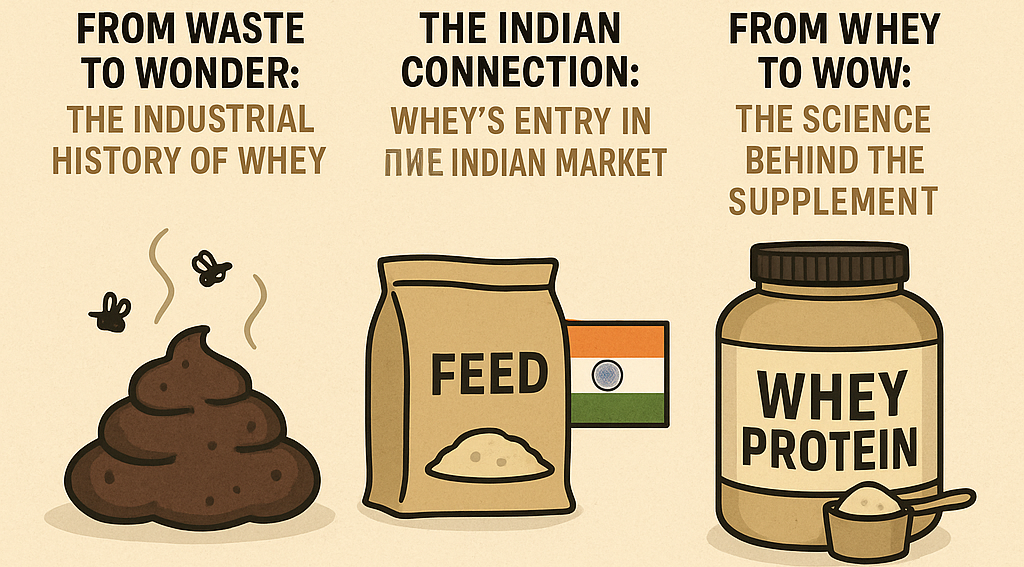Whey protein today is a symbol of fitness, strength, and clean eating. It’s found in gyms, supermarkets, and morning smoothies across India. But what if I told you that whey, once considered a waste product—even imported into India as animal feed or manure from the United States—has now become a multi-crore supplement industry? This blog dives into the fascinating (and surprising) journey of whey protein, tracing its roots from American dairies to Indian muscle-building culture.
💩 From Waste to Wonder: The Industrial History of Whey
In the United States, whey was traditionally a byproduct of cheese manufacturing. When milk is curdled and strained to produce cheese, whey is the liquid left behind. For decades, this leftover liquid—despite its nutrient content—was treated as waste. It was either discarded, dumped into rivers, used as fertilizer, or fed to pigs.
To the food industry, it was “junk protein.” But science told a different story.
By the late 20th century, nutrition researchers began analyzing whey’s composition and were astonished by its complete amino acid profile, particularly its high levels of BCAAs (branched-chain amino acids) like leucine, isoleucine, and valine. These amino acids are crucial for muscle synthesis and recovery, making whey a potent tool for athletes and bodybuilders.
Soon, whey’s image shifted from garbage to gold. The supplement industry in the West seized the opportunity, refining and marketing whey protein powders to meet the growing demand for post-workout nutrition.
🇮🇳 The Indian Connection: Whey’s Entry into the Indian Market
India’s fitness industry started booming in the 2000s, but domestic supplement production was limited. To meet demand, the country began importing whey protein in bulk, mostly from the United States and Europe.
Here’s where it gets controversial.
Many of the early imports came from surplus whey—originally intended for animal consumption. In some reported cases, low-grade whey labeled as “animal feed” or “manure-grade” was repurposed, refined just enough to pass as “food-grade,” and sold in Indian markets under shiny, muscular branding.
These early practices raised critical questions:
- Was the whey genuinely food-safe?
- Were labels hiding the true origins of the product?
- Were Indians consuming glorified animal feed?
Even now, despite better regulations, grey-market imports, counterfeit supplements, and low-grade knockoffs still make their way into gyms and stores. The problem isn’t just the source—it’s the lack of awareness and the absence of strict quality control.
🧪 From Whey to Wow: The Science Behind the Supplement
Despite its questionable origin story, not all whey protein is bad. In fact, high-quality whey protein isolates and concentrates are among the best supplements available for:
- Building muscle
- Supporting weight loss
- Enhancing recovery
- Maintaining overall protein intake
There are three main types of whey:
- Whey Concentrate – Least processed, cheaper, contains some fat and carbs.
- Whey Isolate – More refined, higher protein percentage, lactose-free.
- Whey Hydrolysate – Pre-digested for faster absorption, often used in medical nutrition.
The key is knowing where your whey comes from and how it’s processed.
🛑 The Risks of Poor-Quality or Fake Whey in India
Unfortunately, the Indian supplement market is still plagued with issues, especially in unregulated online stores or smaller gyms:
- Fake whey in duplicate packaging
- Protein powders spiked with cheap fillers, steroids, or sugar
- Misleading nutritional labels
- Lack of third-party testing or certification
These problems not only waste your money—they can damage your kidneys, liver, and long-term health.

✅ How to Choose Safe and Effective Whey Protein in India
If you want to supplement safely, follow these guidelines:
- Check for Authenticity Codes
Use the brand’s app or website to verify product authenticity via QR or scratch codes. - Buy from Reputed Retailers
Avoid shady websites or gym trainers selling “discounted” powders. Stick to platforms like HealthKart, Amazon (with FSSAI compliance), or authorized dealers. - Look for Lab Reports
Choose products that offer third-party lab testing or certification (like Informed Sport, NSF, or FSSAI license). - Read the Label Carefully
Watch out for vague terms like “proprietary blend,” hidden sugars, or artificial fillers. - Know Your Body
If you’re lactose intolerant, go for isolate. If you’re cutting carbs, avoid concentrates with excess sugar.
💬 Final Thoughts
Whey protein’s journey from animal feed in the U.S. to premium supplement in Indian gyms is both eye-opening and cautionary. While the industry has evolved, it’s important for consumers to be informed, alert, and critical of what they’re putting into their bodies.
Whey might have come from a dirty past—but with the right knowledge, you can make it a clean part of your fitness future.





Leave a Reply